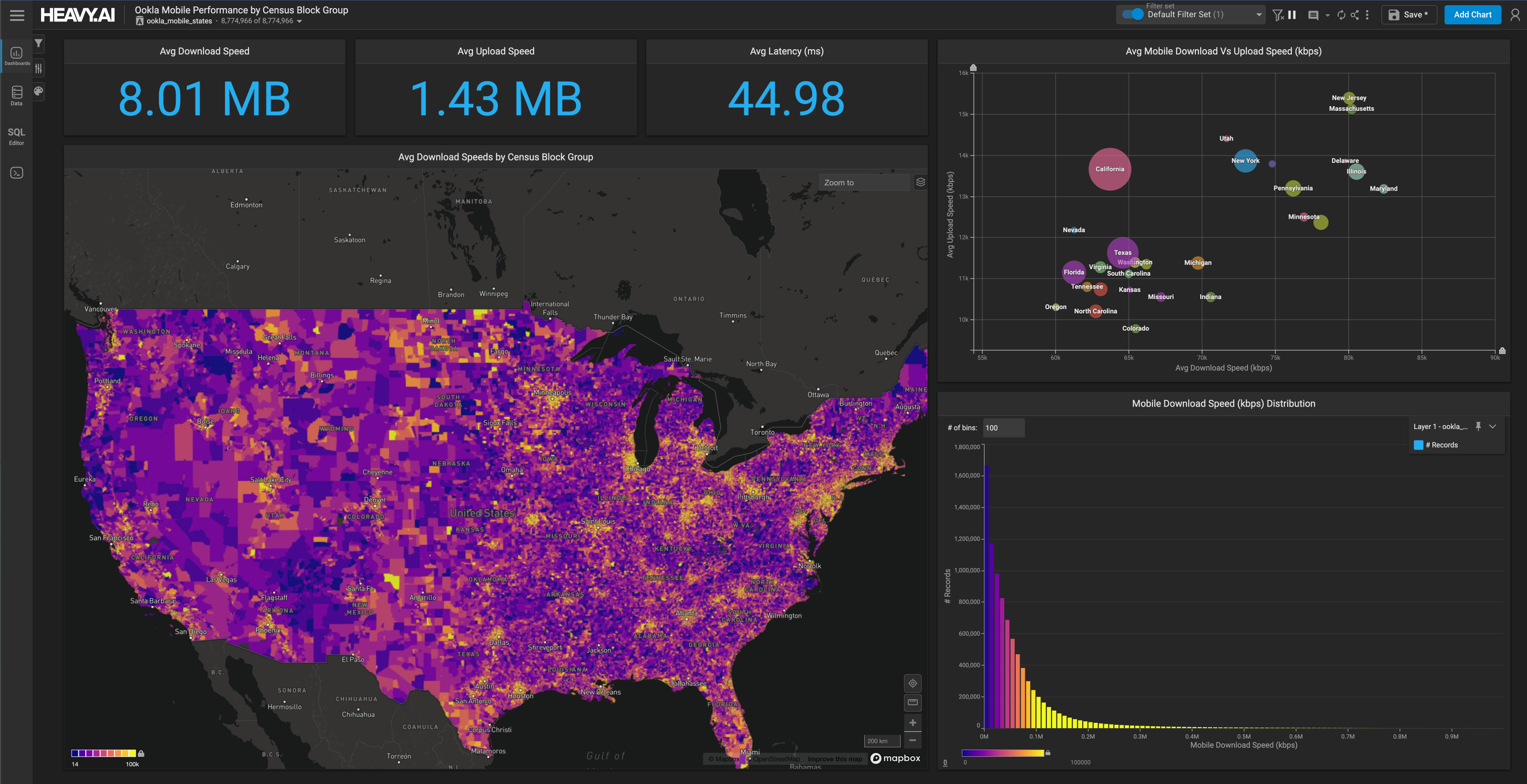
RF Propagation and its Vital Role in 5G
Download HEAVY.AI Free, a full-featured version available for use at no cost.
GET FREE LICENSEThe telecommunications industry has undergone enormous growth in the last three decades. Analog made way for the wireless revolution, which was ushered in by advances in radio frequency, which in turn made way for the digital era, powered by advances in data compression. We enjoyed our 2G cellular networks in the early ‘90s, followed by 3G, then 4G, and now the glossy promises of 5G. A consistent component throughout this evolution has been, and likely always will be, RF propagation. RF propagation, also known as radio frequency propagation or RF wave propagation, is especially relevant in the era of 5G. So what is it exactly?
What is RF Propagation
It’s not a term you regularly see at the top of industry blogs, but it is the foundation of telecommunications, and a major aspect of telecom network design software. Radio frequency propagation is the phenomena by which we can transfer information from Point A to Point B without a physical medium. Specifically, it is the behavior of radio waves as they travel and how they are affected by external phenomena, such as reflection, refraction, diffraction, absorption, polarization, and scattering.
This is highly relevant in the field of telecommunications, as understanding RF signal propagation is crucial to our ability to design an efficient radio communication system with optimized signal strength. Propagation of radio waves is a major component of RF Planning, which is the process of assigning frequencies, transmitter locations, and parameters of a wireless communications system to provide sufficient coverage and capacity for the services required.
Types of RF Propagation
Radio waves can propagate from transmitter to receiver in four different ways: through ground waves, sky waves (Ionospheric), free space waves, and open field waves (Tropospheric):
- Ground wave propagation: Radio signals that travel via ground waves typically travel the Earth’s curvature and tend to be affected by the terrain over which they travel. This type of RF propagation is used during the day time, is ideal for relatively short distance propagation, and is used to provide relatively local radio communications coverage.
- Ionospheric propagation: Also known as sky waves, these radio signals travel through and are influenced by an upper region in the earth's atmosphere called the Ionosphere. This type of RF propagation is used in radio communications systems that transmit on the HF or short wave bands. It is best used at night and is impacted by factors such as radio frequencies used, time of day, electron density, gas molecules, meteor scatter, and electromagnetic radiation.
- Free space propagation: Also known as line-of-sight waves, these radio waves travel through open space freely, apart from any objects that would influence the waves’ travel. Signal strength is impacted only by the distance between the source and the destination. This variety of RF propagation is found in radio communications systems where the signals travel up to the satellite from the ground and back down again. Elements such as the atmosphere very rarely have any effect in instances of free space propagation.
- Tropospheric propagation: Signals propagate through the troposphere, the area of the atmosphere just beyond the optical horizon, are affected by the variations of refractive index in the air, which is affected by factors such as temperature, atmospheric pressure, and water vapor pressure. This type of RF propagation is often how signals at VHF and above are heard over extended distances, which is most relevant to systems such as cellular telecommunications, mobile radio communications, and other wireless systems.
Radio Frequency Propagation Modeling
Different models have been developed to meet the needs of RF propagation in different conditions. RF propagation modeling is an empirical mathematical formulation for the characterization of radio wave propagation as a function of frequency, distance, and other conditions. The three main RF propagation models are for: free space attenuation, outdoor attenuation, and indoor attenuation. Examples include:
- Models for free space attenuation: Free-space path loss; Dipole field strength in free space; Friis transmission equation
- Models for outdoor attenuation: ITU terrain model; Egli model; Two-ray ground-reflection model; Okumura model; Hata model for urban areas; Hata model for suburban areas; Hata model for open areas; COST Hata model
- Models for indoor attenuation: ITU model for indoor attenuation; Log-distance path loss model
Propagation models were developed based on large sets of data collected for specific scenarios for the purpose of formalizing the manner in which radio waves are propagated between transmitter and receiver. RF models typically focus on realizing signal path loss, predicting the area of coverage for a transmitter, and modeling the distribution of signals over different regions.
Why is RF Propagation Important for 5G?
While some of the infrastructure needed for 5G is already in place, small-cell technology must be implemented in densely populated areas in order to increase network capacity. 5G network infrastructure uses mmWave frequencies, which can only cover a short distance and require an ultra-dense grid. 5G infrastructure uses higher band radio frequencies, and small cell antennas are capable of transmitting and receiving these higher band radio frequencies. However, while high frequencies transmit more data, they are highly susceptible to physical interference. That’s where RF propagation analysis comes into play.
Radio frequency propagation modeling is a crucial step in the network planning phase and leverages advanced techniques to accurately predict signal path loss from a transmitter to any location. RF propagation modeling software provides communication service providers (CSPs) with critical data from calibrated models for real-world deployment scenarios, which informs 5G rollout projects and enables CSPs to optimize network coverage for the cost of delivering the network.
When it comes to the challenges of optimizing 5G spectrum, beam forming, commonly seen in WiFi routers, is being deployed in 5G stations to boost signal strength and range in a particular direction, avoiding interference from trees and buildings. These advanced beam-forming techniques include use of constructive and destructive radio interference to make signals directional rather than broadcast. Spatiotemporal data visualizations enable telcos to deliver beam forming features.
RF Propagation Tools for an Evolving Industry
Modern RF propagation software solutions are employed to measure and perform geospatial analysis on radio signal strength, simulate different atmospheres, identify signal path profiles and losses, measure actual customer traffic and usage patterns, and map terrains. These tools can be used to develop coverage studies, predict and plan coverage, and optimize network planning to provide a better network experience.
Accelerated analytics tools can help telecommunications analysts explore the massive datasets related to RF propagation and aid them in their endeavors to optimize 5G network infrastructure. Accelerated analytics tools help data scientists and network operators visualize and explore spatiotemporal data, which can provide real-time insight into RF propagation, help determine optimal network topology, monitor network performance, reduce network interference, and empower the entire telecommunications industry to deliver on all the promises of 5G.




